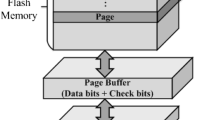Abstract
The NAND flash memories have endurance issues in a high-performance computing (HPC) environment because of their blocks’ limited lifetime. Hence, the NAND flash block allocation and reclamation policies have a significant impact on its lifetime improvement. To address this problem, the scoring-based method is proposed in this paper, which employs priority-based victim block and active block selection methods. The priority of a block is estimated based on both of the score and a time factor. The comprehensive experiments using both realistic and synthetic benchmark traces are performed. The SSDsim simulation environment is extended to implement this method. The results reveal that in comparison with other methods, the proposed method improves endurance by at least 38%.











Similar content being viewed by others
References
Hu Y et al (2011) Performance impact and interplay of SSD parallelism through advanced commands, allocation strategy and data granularity. In: Proceedings of the International Conference on Supercomputing, pp 96–107
Mielke NR et al (2017) Reliability of solid-state drives based on NAND flash memory. Proc IEEE 105(9):1725–1750
Wang W, Xie T (2014) PCFTL: a plane-centric flash translation layer utilizing copy-back operations. IEEE Trans Parallel Distrib Syst 26(12):3420–3432
Compagnoni CM et al (2017) Reviewing the evolution of the NAND Flash technology. Proc IEEE 105(9):1609–1633
Matsui C, Sun C, Takeuchi K (2017) Design of hybrid SSDs with storage class memory and NAND flash memory. Proc IEEE 105(9):1812–1821
Cui J et al (2018) ApproxFTL: on the performance and lifetime improvement of 3-D NAND flash-based SSDs. IEEE Trans Comput Aided Des Integr Circuits Syst 37(10):1957–1970
Sun C, Arakawa A, Takeuchi K (2014) Sea-SSD: a storage engine assisted ssd with application-coupled simulation platform. IEEE Trans Circuits Syst I Regul Pap 62(1):120–129
Yang M-C et al (2016) Reducing data migration overheads of flash wear leveling in a progressive way. IEEE Trans Very Large Scale Integr (VLSI) Syst 24(5):1808–1820
Fang A, Chien AA (2015) How much SSD is useful for resilience in supercomputers. In: Proceedings of the 5th Workshop on Fault Tolerance for HPC at eXtreme Scale. ACM, pp 47–54
Yang Z (2018) Flash-based storage management in cloud computing datacenter infrastructures. Northeastern University
Wan L et al (2017) Optimizing checkpoint data placement with guaranteed burst buffer endurance in large-scale hierarchical storage systems. J Parallel Distrib Comput 100:16–29
Roh H et al (2017) Advanced block nested loop join for extending SSD lifetime. IEEE Trans Knowl Data Eng 29(4):743–756
Tavakkol A et al (2016) Performance evaluation of dynamic page allocation strategies in SSDs. ACM Trans Model Perform Eval Comput Syst 1(2):7
Tsao C-W et al (2015) Efficient victim block selection for flash storage devices. IEEE Trans Comput 64(12):3444–3460
Liu D et al (2017) A workload-aware flash translation layer enhancing performance and lifespan of TLC/SLC dual-mode flash memory in embedded systems. Microprocess Microsyst 52:343–354
Company H-PD (2013) Technical white paper solid state drive technology differences between SLC, MLC and TLC NAND. http://h10032.www1.hp.com/ctg/Manual/c03757461
Affiliates (2016) W.D.C.o.i. Flash 101 and flash management a detailed overview of flash and flash management techniques. https://documents.westerndigital.com/content/dam/doc-library/en_us/assets/public/western-digital/collateral/white-paper/white-paper-sandisk-flash101-management.pdf
Kim B-K, Lee D-H (2015) A wear-leveling algorithm exploiting k-bitwise operations for flash storage devices. IEEE Trans Consum Electron 61(4):470–477
Kim SH, Kwak JW (2016) Garbage collection technique using erasure interval for NAND flash memory-based storage systems. Int J Appl Eng Res 11(7):5188–5194
Chiang M-L, Chang R-C (1999) Cleaning policies in mobile computers using flash memory. J Syst Softw 48(3):213–231
Wu C-H et al (2017) Rethink the design of flash translation layers in a component-based view. IEEE Access 5:12895–12912
Matsui C et al (2016) Write order-based garbage collection scheme for an LBA scrambler integrated SSD. IEEE Trans Very Large Scale Integr (VLSI) Syst 25(2):510–519
Guan Y et al (2017) A block-level log-block management scheme for MLC NAND flash memory storage systems. IEEE Trans Comput 66(9):1464–1477
Gupta A, Kim Y, Urgaonkar B (2009) DFTL: a flash translation layer employing demand-based selective caching of page-level address mappings. ACM Sigplan Not 44(3):229
Wang C, Wong W-F (2012) Observational wear leveling: an efficient algorithm for flash memory management. In: Proceedings of the 49th Annual Design Automation Conference, pp 235–242
Cormen TH et al (2009) Introduction to algorithms. MIT Press, Cambridge
Lee Y et al (2013) Zombie chasing: efficient flash management considering dirty data in the buffer cache. IEEE Trans Comput 64(2):569–581
Wu, G, He X (2012) Delta-FTL: improving SSD lifetime via exploiting content locality. In: Proceedings of the 7th ACM European Conference on Computer Systems, pp 253–266
Chen F, Luo T, Zhang X (2011) CAFTL: a content-aware flash translation layer enhancing the lifespan of flash memory based solid state drives. FAST 11:77–90
Sun C et al (2015) LBA scrambler: a nand flash aware data management scheme for high-performance solid-state drives. IEEE Trans Very Large Scale Integr VLSI Syst 24(1):115–128
Capps D, Norcott W (2014) IOzone filesystem benchmark. Availavle: http://www.iozone.org/
Coker R (2001) The Bonnie++ benchmark. http://www.coker.com.au/bonnie++/
Axboe J (2016) Flexible i/o tester. https://github.com/axboe/fio
Brunelle AD (2006) Block i/o layer tracing: blktrace. HP, Gelato-Cupertino, CA, USA
Walpole RE et al (2011) Probability and statistics for engineers and scientists. Pearson Education, London
Author information
Authors and Affiliations
Corresponding author
Additional information
Publisher's Note
Springer Nature remains neutral with regard to jurisdictional claims in published maps and institutional affiliations.
Rights and permissions
About this article
Cite this article
Khanbadr, A., Binesh Marvasti, M., Asghari, S.A. et al. A novel method for victim block selection for NAND flash-based solid state drives based on scoring. J Supercomput 76, 10186–10211 (2020). https://doi.org/10.1007/s11227-020-03250-w
Published:
Issue Date:
DOI: https://doi.org/10.1007/s11227-020-03250-w




